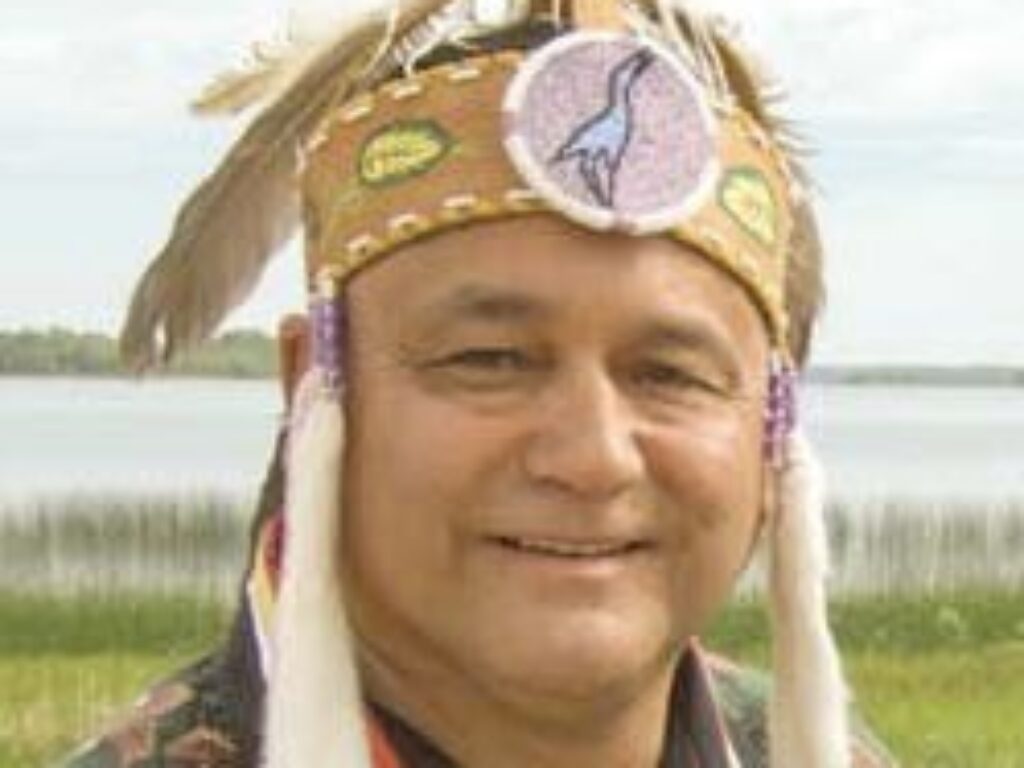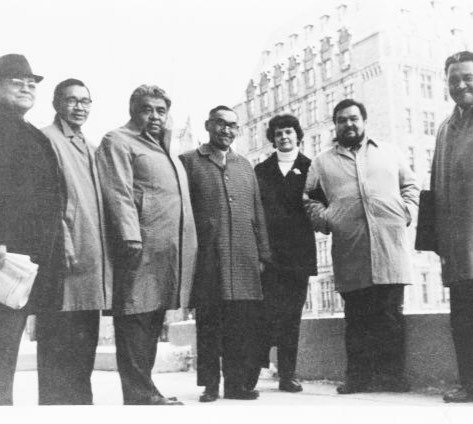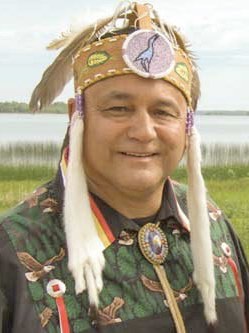Law
A number of court cases have provided landmark decisions in cases involving Aboriginal Rights and Title.
“The vote…has paved the way for new rights and new responsibilities. Indians now have a legal voice in the affairs of the province and a right to ask for equality of citizenship. Today the Indian stands as a second-class citizen, robbed even of his native rights… my picture of a full Magna Carta for natives is equality of opportunity in education, in health, in employment and in citizenship.”
-Frank Calder
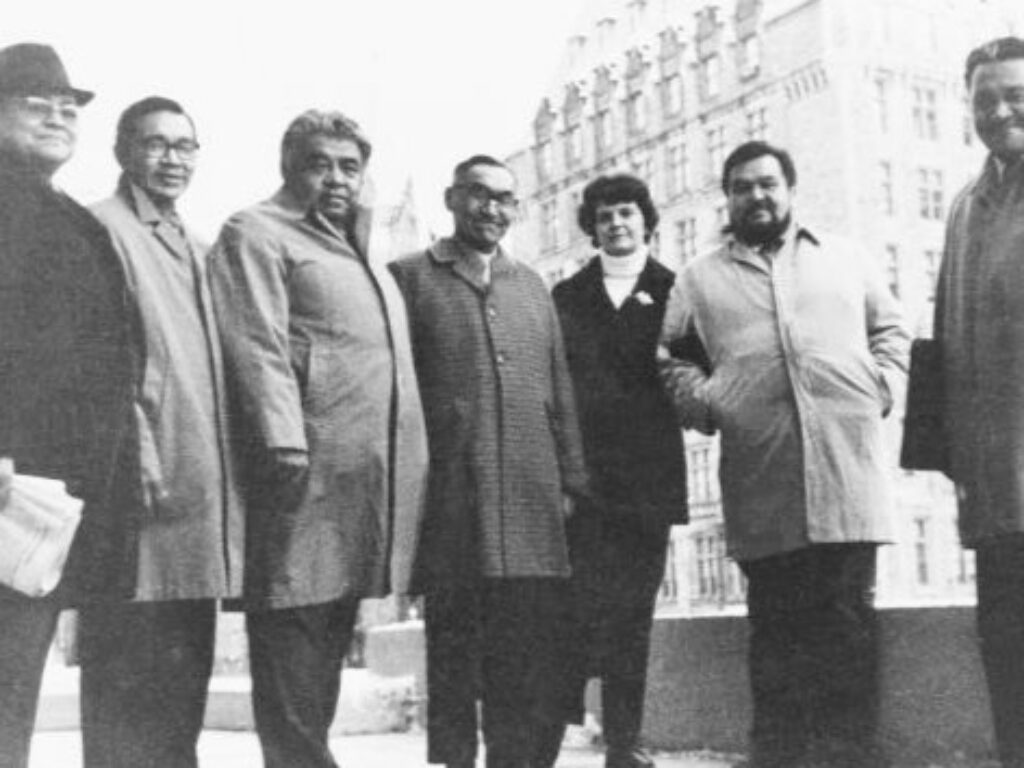
The 1967 Calder case involved Frank Calder and several Nisga’a elders who brought a lawsuit against British Columbia, claiming their land title had been illegally abrogated. Although the judgment wasn’t in the Nisga’a favour, it’s considered a landmark moment for Indigenous land rights because the Supreme Court of Canada cited the Royal Proclamation of 1763. Issued by King George III of England, it decreed that Aboriginal land title in North America existed and would continue until treaty extinguished it, and forbade settlers from acquiring land from Aboriginals, either by purchase or by force.
On June 26, 2014, the Supreme Court of Canada ruled that the Tsilquot’in First Nation, residing in central British Columbia, did possess clear Aboriginal title to around 1800 square kilometres of ancestral land—and that the forestry licences issued to logging companies in the early 1980s had violated the Tsilquot’in right to determine how their lands are used. The case was a triumph for Indigenous rights.
There are five types of challenges with understanding what treaties really mean, largely because of differences in worldviews held by the Europeans and First Nations.
The first challenge has to do with the meaning and symbolism of the word “land.” There is a profound difference between “sharing land” (the view of the First Nations) and “owning land” (the view of the Europeans).
The meaning of “land” to First Nations is expressed in this quote from Canada in the Making:
The concept of land ownership was completely alien to the Native peoples. From an Aboriginal cultural and spiritual perspective, land cannot be bought or sold. They saw themselves as the spiritual guardians of the land, not its actual owners. Land was considered a gift from the Creator or Great Spirit, and its resources were to be used for survival purposes only. Thus, the concept of ‘surrendering’ land was one that caused great confusion within Aboriginal communities…
As stated in http://firstpeoplesofcanada.com/fp_treaties/fp_treaties_two_views.html:
First Nations believed they were merely giving the new settlers the right to use some of their lands for farming. First Nations people are certain they had no thought of giving up all title to their land, nor could they even comprehend the concept of extinguishment of all title and all rights to their land forever.
The second challenge concerns the form or process of the treaties. Europeans used written statements to formalize agreements, while First Nations relied on verbal or oral forms as their “documents.” In signing treaties with Europeans, First Nations were using a foreign medium—a written document—with implications that the First Nations could not possibly have been aware of or understood. As expressed in Treaties & Cultural Change:
First Nations had an oral tradition. They passed down important information by the spoken word during important ceremonies and at celebrations. What was said was what was important to them, not what was written on paper.
Although First Nations had no written tradition, some First Nations had developed the Wampum Belt—a visual form of telling a story, recording an agreement and serving a range of other ceremonial functions.
Nations saw themselves as sovereign and distinct peoples who were entering a relationship with other sovereign and distinct peoples, the Europeans. From the perspective of the First Nations, there would be respect for the traditions, cultures, religions and customs of both signatories to the Treaties. However, it was clear that the Europeans viewed the Treaties as the beginning of the assimilation of First Nations into the worldview and customs of the Europeans, a position of the European nations that would have profound consequences on the future health, stability, and integrity of First Nations peoples and communities.
The fourth challenge concerns the scope of the Treaties, in what might be termed a literal versus a spirit and intent character. Europeans took a very literal understanding of the Treaties, meaning that the obligations and responsibilities were limited to the terms that were specified and laid out in the Treaties. First Nations, on the other hand, had a wider and broader understanding and perspective of the terms outlined in the Treaties. For First Nations, treaties were only a starting point. First Nations saw verbal obligations, responsibilities or statements made by the original European negotiators as inherent components of the Treaties—honour and honesty were valued. Treaties were seen as living and dynamic agreements that continued to develop and unfold as the circumstances of both signatories changed and evolved.
The fifth challenge has to do with language. Professional, experienced translators know well that serious errors can be made when translating an idea, a statement, even a word, from one language into another. For example, a word in one language may not have a precise counterpart or may have a variety of counterparts in another language. Because of the very nature and complexities of languages, it’s rare for any translation to be absolutely perfect and an exact copy. These potential errors can be magnified when translation is conducted by people who are not trained in the subtleties of languages and who may be unaware of the influence that context can have on translated words, phrases or concepts. The translation minefield can be made even more treacherous when a document is written by only one side and in that side’s language, but must be understood and accepted by someone speaking another language.
After the creation of the Dominion of Canada in 1867, treaties continued to be signed with First Nations, with the role of the European nations assumed by the Government of Canada. By necessity, this Plain Talk can provide only a brief overview of the topic of treaties by focusing on the nature, history and problems encountered. A huge volume of material is available in hard copy in various archives and on the Internet for people who wish to learn more.
Both Manitoba and Saskatchewan have produced excellent resources devoted entirely to the critical topic of treaties:
The Manitoba Treaty Education Initiative Tool Kit, developed by the Treaty Relations Commission of Manitoba (TRCM); and the Saskatchewan Treaty Kit K-12, developed by the Office of the Treaty Commissioner. Both resources should be consulted for definitive and extensive coverage of treaties and treaty relationships.
The theatre offers an excellent arena for exploring delicate and controversial issues. Governor General Award-winning playwright Ian Ross has written a wonderful, funny, and insightful play about treaties. Titled Kinikinik, the play explores the issues concerning treaties. The playwright uses a willow branch as a symbol for land. Two characters, a Wolf and a Beaver, compete for possession or ownership of the willow.
A third character, a Turtle, leads the Wolf and Beaver through the discovery that it’s not easy to resolve possession of the willow. The characters discover that a verbal agreement might not be sufficient. They also discover that a written agreement like a treaty could be unfair if the agreement is created by only one side and in language that might not be completely understood by the other party. Whether read out loud by a group, or performed by an amateur or professional theatre group, Kinikinik is a powerful exploration of the intricacies of the creation, implementation, and interpretation of treaties.
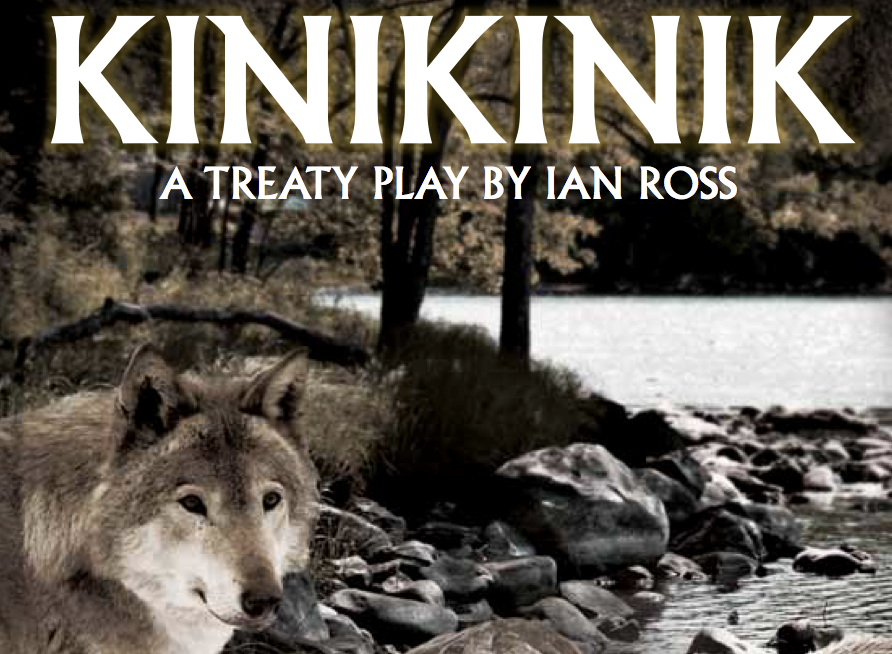
Read Kinikinik, A Treaty Play by Ian Ross.
pdf • 974 KB
Treaties, as agreements between sovereign entities like nations, invariably establish a relationship between the nations. The phrase “we are all treaty people” springs from the work of the Treaty Relations Commission of Manitoba. We are all treaty people is a concise statement that both First Nations and Canadians are integral partners in every treaty, and that we all have the responsibility to ensure that treaties be honoured and respected. It is unfortunate that Canadian governments have consistently failed First Nations by ignoring or not fulfilling their treaty commitments. By acknowledging and implementing its treaty obligations, Canadian governments could make significant steps in reversing and resolving a range of inequities endured by First Nations. This is especially deplorable given Canada’s endorsement of the United Nations Declaration on the Rights of Indigenous Peoples (UN Declaration) in 2010 and 2016.
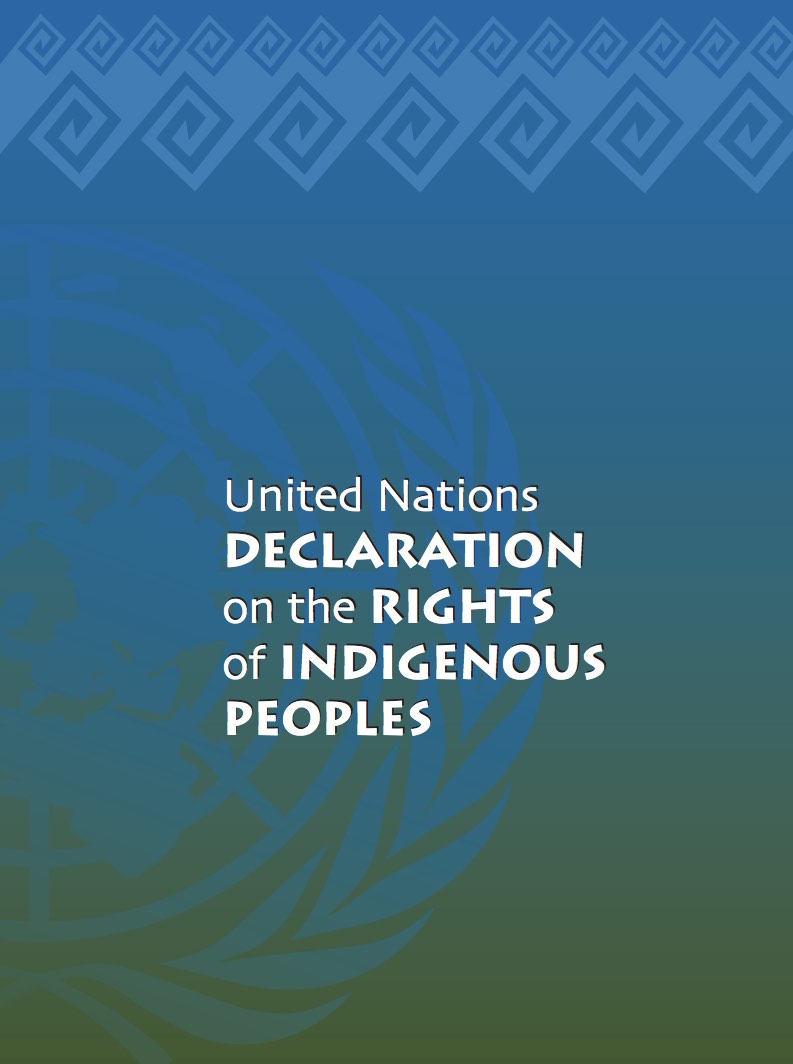
Read the United Nations Declaration on the Rights of Indigenous Peoples (UN Declaration).
pdf • 166 KB
Grand Council Chief Madahbee of the Anishinabek Nation, in a letter to the Prime Minister of Canada, has expressed his dismay at the federal government’s continuing efforts to erode First Nations treaty and inherent rights.
November 21, 2012
Dear Prime Minister Harper:
Over the past couple of years it has become increasingly apparent to the Anishinabek First Nations that the federal government is on a path to dissolving First Nation treaty and inherent rights through infringing legislation. We have received copies of several letters from First Nation organizations like the Assembly of First Nations, the Chiefs of Ontario and other political organizations across the country, opposing federal legislation that impacts First Nations. At the Anishinabek Nation we have sent numerous letters and presented our reasons for objection to the various federal standing committees on legislation that the Government of Canada seems determined to ram through parliament.
During the Harmonized Sales Tax legislation process, First Nations in Ontario unified to oppose the federal and provincial objective to combine taxation policies and eliminate the provincial retail sales tax exemptions for First Nation citizens. The very next year the federal Ministry of Revenue began taking First Nation working-class citizens to court on income tax policies, despite their treaty right not to be taxed within their own territories. Nearly every legislation or policy impacting First Nations which the federal government has introduced over the past couple of years will either eliminate First Nation treaty rights or minimize the Crown’s treaty and fiduciary responsibilities to First Nations in Canada. I cannot make myself any more clear: all lands and resources in Canada belong to First Nations’ people and no amount of legislation will take that fact away.
Some of the Bills we oppose include: Bill S-2 (Matrimonial Real Property), Bill S-6 (First Nations Election Act), Bill C-10 (Crimes Bill), Bill S-8 (Safe Drinking Water), Bill C-27 (Financial Transparency Act), Bill C-45 (Jobs and Growth Act, specifically sections amending the Indian Act and Fisheries), and Bill C-428 (Private Member’s Bill, specifically to amend the Indian Act). I wish to put it on record again that the Anishinabek First Nations oppose, reject and dismiss each and every bill that encroaches on First Nations’ treaty and inherent rights. Making sweeping changes that will impact First Nations (through legislation) without inclusion of First Nations in the development of these bills is contrary to a Nation-to-Nation relationship. The resolve of our citizens will be known across the country and we will bring national attention to the colonial approach Canada continues to push for in relation to First Nation territories and First Nation citizens’ rights.
First Nations have a unique legal and historical relationship with Canada as established through treaties and alliances during times of war and peace. We have remained a loyal ally over many decades, only to watch our children get siphoned into residential schools and our land exploited for the betterment of Canada and to the detriment of First Nations. As the Grand Council Chief of the Anishinabek Nation I have limited authority as mandated by our leadership. However I am in a position to remind Canada that First Nations will not sit quietly while funding to education is frozen, funding to health is cut, and land claims are held hostage to surrender clauses while mining companies are fast- tracked to exploit our lands in order to keep Canada listed as one of the wealthiest countries in the world. First Nations socio-economic indicators continue to represent human rights issues comparable to those of many oppressed populations throughout the world. I cannot, nor would I ever attempt to, control or stop First Nation citizens if they ever decide to have their voices heard in a free and democratic society. The reputation of Canada is darkened by First Nation realities in Canada. Let us work together to make Canada a better country by engaging in meaningful dialogue that does not include a hidden agenda to assimilate and municipalize First Nations through oppressive legislation and policies.
—Grand Council Chief Madahbee of the Anishinabek Nation
Listen to a reading of the letter
